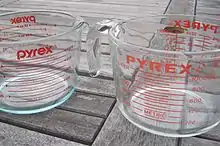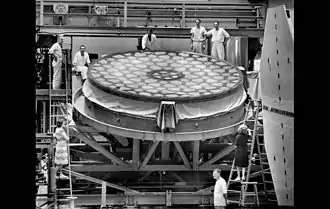Pyrex
Pyrex (trademarked as PYREX) is a brand introduced by Corning Inc. in 1915 for a line of clear, low-thermal-expansion borosilicate glass used for laboratory glassware and kitchenware. It was later expanded to include clear and opal ware products made of soda-lime glass.

Corning no longer manufactures or markets consumer glass kitchenware and bakeware. Corelle Brands, which was spun off from Corning Inc. in 1998 under the name Corning Consumer Products Company and since renamed, continues to license the pyrex (all lowercase) brand for their tempered soda-lime glass line of kitchenware products sold for the consumer market in the United States, South America, and Asia. In the regions of Europe, Africa, and the Middle East, the PYREX (all uppercase) brand is licensed by International Cookware for use on their borosilicate glass products. The brand name has also been used for non-glass kitchen utensils and cookware in various regions for several decades.
History


Borosilicate glass was first made by German chemist and glass technologist Otto Schott, founder of Schott AG in 1893, 22 years before Corning produced the Pyrex brand. Schott AG sells the product under the name "Duran".
In 1908, Eugene Sullivan, director of research at Corning Glass Works, developed Nonex, a borosilicate low-expansion glass, to reduce breakage in shock-resistant lantern globes and battery jars. Sullivan had learned about Schott's borosilicate glass as a doctoral student in Leipzig, Germany. Jesse Littleton of Corning discovered the cooking potential of borosilicate glass by giving his wife Bessie Littleton a casserole dish made from a cut-down Nonex battery jar. Corning removed the lead from Nonex and developed it as a consumer product.[1] Pyrex made its public debut in 1915 during World War I, positioned as an American-produced alternative to Duran.
A Corning executive gave the following account of the etymology of the name "Pyrex":[2]
The word PYREX is probably a purely arbitrary word which was devised in 1915 as a trade-mark for products manufactured and sold by Corning Glass Works. While some people have thought that it was made up from the Greek pyr and the Latin rex, we have always taken the position that no graduate of Harvard would be guilty of such a classical hybrid. Actually, we had a number of prior trade-marks ending in the letters ex. One of the first commercial products to be sold under the new mark was a pie plate, and in the interests of euphonism the letter r was inserted between pie and ex and the whole thing condensed to PYREX.
In the late 1930s and 1940s, Corning also introduced other products under the Pyrex brand, including opaque tempered soda-lime glass for bowls and bakeware, and a line of Pyrex Flameware for stovetop use; this aluminosilicate glass had a bluish tint caused by the addition of alumino-sulfate.[3][4] In 1958 an internal design department was started by John B. Ward. He redesigned the Pyrex ovenware and Flameware. Over the years, designers such as Penny Sparke, Betty Baugh, Smart Design, TEAMS Design, and others have contributed to the design of the line.
Corning divested itself of the Corning Consumer Products Company (now known as Corelle Brands) in 1998 and production of consumer Pyrex products went with it. Its previous licensing of the name to Newell Cookware Europe remained in effect.[5] France-based cookware maker Arc International acquired Newell's European business in early 2006[6] to own rights to the brand in Europe, the Middle East and Africa.[7][8] In 2007, Arc closed the Pyrex factory in Sunderland moving production to France. The Sunderland factory had first started making Pyrex in 1922 [9] In 2014, Arc International sold off its Arc International Cookware division which operated the Pyrex business to Aurora Capital for its Resurgence Fund II. The business now operates as International Cookware.[10]
Composition

Older clear-glass Pyrex manufactured by Corning, Arc International's Pyrex products, and Pyrex laboratory glassware are made of borosilicate glass. According to the National Institute of Standards and Technology, borosilicate Pyrex is composed of (as percentage of weight): 4.0% boron, 54.0% oxygen, 2.8% sodium, 1.1% aluminum, 37.7% silicon, and 0.3% potassium.[11][12]
According to glass supplier Pulles and Hannique, borosilicate Pyrex is made of Corning 7740 glass and is equivalent in formulation to Schott Glass 8330 glass sold under the "Duran" brand name.[13] The composition of both Corning 7740 and Schott 8330 is given as 80.6% SiO2, 12.6% B2O3, 4.2% Na2O, 2.2% Al2O3, 0.1% CaO, 0.1% Cl, 0.05% MgO, and 0.04% Fe2O3,
Beginning in the 1980s, production of clear Pyrex glass cookware manufactured by Corning (and later Corelle Brands, after the consumer division was spun off and renamed) was shifted to tempered soda-lime glass, like their opal bakeware.[14] This change was justified by stating that soda-lime glass has higher mechanical strength than borosilicate—making it more resistant to physical damage when dropped, which is believed to be the most common cause of breakage in glass bakeware. Also, it is cheaper to produce and more environmentally friendly. However, its thermal shock resistance is lower than borosilicate's, leading to potential breakage from heat stress if used contrary to recommendations. European Pyrex is still made from borosilicate.[5][15][16]
The differences between Pyrex-branded glass products has also led to controversy regarding safety issues—in 2008, the U.S. Consumer Product Safety Commission reported it had received 66 complaints by users reporting that their Pyrex glassware had shattered over the prior ten years yet concluded that Pyrex glass bakeware does not present a safety concern. The consumer affairs magazine Consumer Reports investigated the issue and released test results, in January 2011, confirming that borosilicate glass bakeware was less susceptible to thermal shock breakage than tempered soda lime bakeware.[17] However, they admitted their testing conditions were "contrary to instructions" provided by the manufacturer.[4][18] STATS analyzed the data available and found that the most common way that users were injured by glassware was via mechanical breakage, being hit or dropped, and that "the change to soda lime represents a greater net safety benefit."[15]
Use in telescopes

Because of its low expansion characteristics, Pyrex borosilicate glass is often the material of choice for reflective optics in astronomy applications.
In 1932, George Ellery Hale approached Corning with the challenge of fabricating the 200-inch (5.1 m) telescope mirror for the California Institute of Technology's Palomar Observatory project.[19] A previous effort to fabricate the optic from fused quartz had failed, with the cast blank having voids. The mirror was cast by Corning during 1934–1936 out of borosilicate glass.[20] After a year of cooling, during which it was almost lost to a flood, the blank was completed in 1935. The first blank now resides in the Corning Museum of Glass.[21]
Acquisition
Duralex was acquired by the parent of rival Pyrex, International Cookware group for 3.5 million euros ($4.2m).[22]
References
- Corning Pyrex Bakeware, Carroll M. Gantz, Design Chronicles: Significant Mass-produced Designs of the 20th Century, Schiffer Publications, Ltd. 2005
- Mathews, MM (1957). "title unknown". American Speech. 32 (4): 290.
- "PYREX Flameware". The Antique Attic. Archived from the original on January 4, 2011. Retrieved 5 June 2015.
- "Exploding Pyrex, Urban Legend reference". Snopes.com. Retrieved 2011-01-08.
- "Manufacturing History". Pyrex Products. Archived from the original on 2 October 2011. Retrieved 5 June 2015.
- "Arc International page". Hoover's. Archived from the original on 29 September 2007. Retrieved 5 June 2015.
- Hibberd, Susan (2007). The Little Book of Collectable British Pyrex. Exposure Publishing. ISBN 978-1-84685-556-6.
- "Glass Ovenware". Arc International. 2005. Archived from the original on 2008-03-11. Retrieved 2008-03-17.
- "BBC Inside Out -". www.bbc.co.uk.
- Group, Aurora Capital. "Aurora Capital Group Completes Acquisition of Arc International Cookware". www.prnewswire.com.
- "Composition of Pyrex Glass". National Institute of Standards and Technology. Retrieved September 8, 2016.
- "How Pyrex is Made". MadeHow.com. n.d.
- "Borosilicate glass". Archived from the original on 15 March 2012. Retrieved 5 June 2015.
- Aikins, Jim. "Setting the Record Straight: The Truth About PYREX". Pyrex Products. Archived from the original on 26 October 2011. Retrieved 5 June 2015.
- Butterworth, Trevor (14 October 2009). "Exploding the exploding Pyrex rumor". STATS. Statistical Assessment Service. Archived from the original on 20 November 2014. Retrieved 5 June 2015.
- Consumer Reports Breaks A Lot Of Glass Investigating Shattering Pyrex Bakeware, The Consumerist
- Estes, Adam Clark (March 16, 2019). "The Pyrex Glass Controversy That Just Won't Die". Gizmodo. Retrieved 2019-03-22.
- "FOIA requests examine glass bakeware that shatters". Consumer Reports. Archived from the original on 6 December 2011. Retrieved 7 February 2012.
- "The Glass Giant". Corning Museum of Glass. Corning Museum of Glass. Retrieved 30 January 2015.
- "A History of Palomar Observatory". Palomar Observatory. California Institute of Technology. 28 May 2015. Retrieved 5 June 2015.
- "200-inch Disk". Corning Museum of Glass. Corning Museum of Glass. Retrieved 30 January 2015.
- AFP (2021-01-29). "French glassmaker Duralex purchased by rival". DAWN.COM. Retrieved 2021-01-29.
Sources
- DeGuire, Ellen (September 11, 2012). "New paper addresses causes of shattering glass cookware; margin of safety described as 'borderline'". American Ceramic Society. Retrieved 2012-09-17.
Their investigation confirmed the borosilicate glass would withstand a much larger rapid temperature change. According to their calculation and those of others, soda lime glass cookware shatters more frequently because, in theory, it can only resist fracture stress for temperature differentials less than about 55 °C (99 °F). In contrast, they estimate that the borosilicate glassware could tolerate a temperature differential of about 183 °C (330 °F), a three-fold difference.
- Gantz, Carroll, (2001). DESIGN CHRONICLES: Significant Mass-produced Products of the 20th Century, Schiffer Publishing, ISBN 978-0-7643-2223-5
- Rogove, Susan Tobier; Steinhauer, Marcia B. (1993). Pyrex by Corning: A Collector's Guide. Antique Publications. ISBN 0-915410-94-X. OCLC 28440879.
